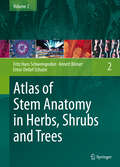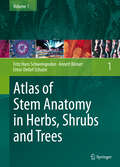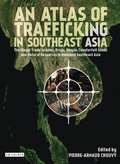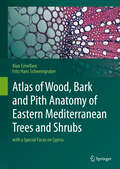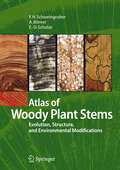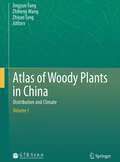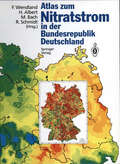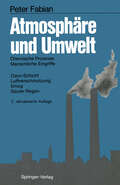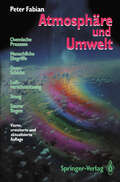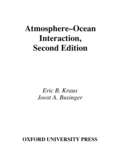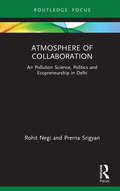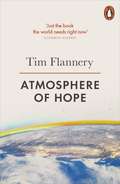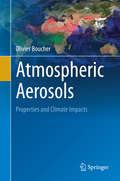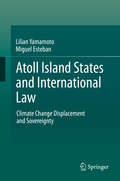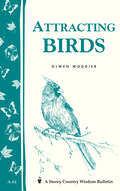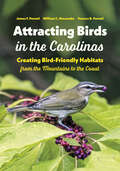- Table View
- List View
Atlas of Stem Anatomy in Herbs, Shrubs and Trees: Volume 2
by Fritz Hans Schweingruber Annett Börner Ernst-Detlef SchulzeThis work, published in two volumes, contains descriptions of the wood and bark anatomies of 3000 dicotyledonous plants of 120 families, highlighting the anatomical and phylogenetic diversity of dicotyledonous plants of the Northern Hemisphere. The first volume principally treats families of the Early Angiosperms, Eudicots, Core Eudicots and Rosids, while the second concentrates on the Asterids. Presented in Volume 2 are microsections of the xylem and phloem of herbs, shrubs and trees of 1000 species and ca. 35 families of various life forms of the temperate zone along altitudinal gradients from the lowland at the Mediterranean coast to the alpine zone in Western Europe. Special attention is given to the very diverse family of Asteraceae. The global perspective of the findings is underlined by the analysis of 400 species from the Caucasus, the Rocky Mountains and Andes, the subtropical zone on the Canary Islands, the arid zones in the Sahara, in Eurasia, Arabia and Southwest North America, New Zealand and the boreal and arctic zones in Eurasia and Canada. The presence of annual rings in all life forms demonstrates that herbs and dwarf shrubs are an excellent tool for the reconstruction of annual biomass production and the interannual dynamic of plant associations. The common principle of the anatomical expression of secondary growth is a key factor in understanding evolution and adaptation processes in all life forms, from the 3 cm tall crepide pigmea (Crepis pygmaea) in the alpine zone to the 40 m tall ash (Fraxinus excelsior) in Central European riparian forests. The study opens vast fields of research for dendrochronology, wood anatomy, taxonomy and ecology.
Atlas of Stem Anatomy in Herbs, Shrubs and Trees: Volume 1
by Fritz Hans Schweingruber Annett Börner Ernst-Detlef SchulzeThis work, published in two volumes, contains descriptions of the wood and bark anatomies of 3000 dicotyledonous plants of 120 families, highlighting the anatomical and phylogenetic diversity of dicotyledonous plants of the Northern Hemisphere. The first volume principally treats families of the Early Angiosperms, Eudicots, Core Eudicots and Rosids, while the second concentrates on the Asterids. Presented in Volume 1 are microsections of the xylem and phloem of herbs, shrubs and trees of 1200 species and 85 families of various life forms of the temperate zone along altitudinal gradients from the lowland at the Mediterranean coast to the alpine zone in Western Europe. The global perspective of the findings is underlined by the analysis of 500 species from the Caucasus, the Rocky Mountains and Andes, the subtropical zone on the Canary Islands, the arid zones in the Sahara, in Eurasia, Arabia and Southwest North America, and the boreal and arctic zones in Eurasia and Canada. The presence of annual rings in all life forms demonstrates that herbs and dwarf shrubs are an excellent tool for the reconstruction of annual biomass production and the interannual dynamic of plant associations. The common principle of the anatomical expression of secondary growth is a key factor in understanding evolution and adaptation processes in all life forms, from the 2 cm tall whitlow grass (Draba arctica) in the arctic to the 40 m tall beech (Fagus sylvatica) in Central European managed forests. The study opens vast fields of research for dendrochronology, wood anatomy, taxonomy and ecology.
An Atlas of Trafficking in Southeast Asia: The Illegal Trade in Arms, Drugs, People, Counterfeit Goods and Natural Resources in Mainland Southeast Asia (International Library Of Human Geography Ser.)
by Pierre-Arnaud ChouvyMainland Southeast Asia is one of the world's key regions for the smuggling and trafficking of illegal goods. Armed conflict in the region has spurred an international trade in small arms, and organized nuclear smuggling rings are now believed to operate as well. Human trafficking is widespread, with children being especially vulnerable either for slave labour or sexual exploitation. The region is being flooded with contraband and counterfeit goods such as pirated movies, designer label clothes and currency, especially US dollars, whilst antiques, oil and medicinal drugs - counterfeit as well as authentic ones - are also being smuggled.While such activity has been drawing increased attention, the scope, nature and mechanisms of smuggling and trafficking across the region are far from understood. Even less is known about the various synergies that may exist between the different trafficking activities. An Atlas of Trafficking in Southeast Asia brings together a team of key researchers and cartographic specialists to provide a unique overview of the major forms of illegal trafficking in the region. The contributors have been drawn from a range of disciplines, reflecting the complex reality of this diverse and thriving illegal economy. Geographer Pierre-Arnaud Chouvy provides a history of the drug trafficking routes in and out of the Golden Triangle, whose opium and heroin networks have played such a significant role in both the regional and global history. Anthropologist David Feingold, focuses on human smuggling and trafficking, a highly complex trade with many causes and consequences, whilst political scientist David Capie examines the illegal trade in small arms. There has been impressive rhetoric about the need to tackle the illicit arms trade but much less in the way of practical action. Southeast Asia has the highest rate of deforestation of any major tropical region, whilst wildlife is currently being extracted at six times the sustainable rate. Vanda Felbab-Brown, also a political scientist, examines the key interrelated topics of illegal logging and wildlife trafficking. Finally, journalist Bertil Lintner surveys the trade in counterfeit goods and contraband, two thriving activities in mainland Southeast Asia. Accompanying the text is a unique series of thirty-two full-colour maps. These maps have been especially drawn for the atlas and detail the trafficking hubs, counter-trafficking facilities and border status for each of the trafficking activities. Political, historical, topographic, ecological and linguistic regional maps are also included. An Atlas of Trafficking in Southeast Asia sheds valuable light on the complex and shadowy world of one of the key regions for illegal trading. An unparalleled reference resource, it will be welcomed by professionals and academics across a wide range of disciplines.
Atlas of Wood, Bark and Pith Anatomy of Eastern Mediterranean Trees and Shrubs: with a Special Focus on Cyprus
by Alan Crivellaro Fritz Hans SchweingruberThis atlas presents anatomical descriptions of the xylem, bark and pith of 264 species belonging to 71 families. It highlights the anatomical diversity of trees, shrubs, dwarf shrubs, woody lianas and several of the prominent perennial herbs from the Eastern Mediterranean region, with a focus on the island of Cyprus. The island’s topography and biogeographic history combine to provide a wide range of habitats and diverse flora including widespread, endemic, and ornamental species.The monograph for each species includes a description of the anatomical structures of the stem and twig xylem and the twig’s bark and pith, as well as color micrographs of double-stained sections of each of these plant parts. These entries are accompanied by a photograph and a brief description of the plant including stem wood density, height, habit, flower, leaf and fruit characteristics, and a map showing its geographic and altitudinal distribution in the region. Xylem descriptions follow the IAWA lists of microscopic features for hardwood and softwood identification. For bark and pith descriptions, a new coding system developed by the authors is applied. Lastly, the work offers a key for wood identification that was developed to differentiate between groups of species by using a small number of features that are unambiguous and clearly visible. The atlas will be a valuable guide for botanists, ecologists, foresters, archeologists, horticulturists and paleobotanists.
Atlas of Woody Plant Stems: Evolution, Structure, and Environmental Modifications
by Fritz Hans Schweingruber Annett Börner Ernst-Detlef SchulzeThis atlas gives a unique assemblage of microscopic slides of wood anatomy and of the respective species in nature and demonstrates the reaction of stem anatomy to environments in which plants form woody stems. It provides insight into the evolution of wood, to the variation of wood anatomy in response to climate and disturbances, and it gives an introduction to the methodology used to study wood. Special attention has been given to the unique feature of secondary growth. In color throughout and with more than 700 both beautiful and instructive illustrations, the wide-ranging scientific content of this book makes it both attractive and unique.
Atlas of Woody Plants in China: Distribution and Climate
by Jingyun Fang Zhiheng Wang Zhiyao Tang"Atlas of Woody Plants in China: Distribution and Climate” documents the spatially-explicit county-level distribution of all 11,405 woody plants in China, together with life form information for most species. It also provides climate information for each species, with the county-level average and range of 12 climatic indices and of vegetation net primary productivity. It is the first and largest comprehensive atlas in the world for the distribution of China’s plants and was compiled on the basis of almost all related literature published throughout China. The atlas should serve as an indispensable handbook for all those who are interested in the plants, ecology, geography, environment, horticulture, and silviculture of China and East Asia. Dr. Jingyun Fang is a Cheung Kong Professor at the Department of Ecology, Peking University, China. Dr. Zhiheng Wang and Dr. Zhiyao Tang are both ecologists working at the same institute.
Atlas zum Nitratstrom in der Bundesrepublik Deutschland: Rasterkarten zu geowissenschaftlichen Grundlagen, Stickstoffbilanzgrößen und Modellergebnissen
by R. Becker S. Biermann K. Großmann I. Hiller K. J. Hülsbergen R. Michel A. Schumacher U. SturmAtmosphäre und Umwelt: Chemische Prozesse - Menschliche Eingriffe - Ozon-Schicht - Luftverschmutzung Smog - Saurer Regen
by Peter FabianUnsere Atmosphäre, das Luftmeer, auf dessen Grunde wir leben, ist ein Gasgemisch, das neben den Hauptbestandteilen Stickstoff und Sauerstoff eine Vielzahl von Spurengasen enthält. Dieses Gasgemisch an sich wäre reaktionsträge und somit von geringem chemischen Interesse, würde es nicht im Wechsel von Tag und Nacht und im Rhythmus der Jahreszeiten von der Sonne bestrahlt. Die Sonnenstrahlung, insbesondere ihr energie reicher Ultraviolettanteil, vermag die meisten Konstituenten des atmo sphärischen Gasgemisches in ihre Bestandteile zu spalten. Durch diesen photochemischen Prozeß, den man als "Photolyse" oder "Photodissozia tion" bezeichnet, entstehen äußerst reaktive Substanzen, die für uns Erdbewohner wichtige chemische Reaktionsketten auslösen. Lediglich die atmosphärischen Edelgase, Argon, Neon, Helium und Krypton (in der Reihenfolge ihrer Häufigkeit) nehmen an diesen Prozessen nicht teil. Der wohl wichtigste photochemische Prozeß in unserer Atmosphäre ist die Bildung von Ozon (s. Abschnitt 2). Ozon ist die dreiatomige Form des Luftsauerstoffs, 0 • Der normale Sauerstoff besteht aus O , zwei mit 3 2 einander verbundenen Sauerstoff-Atomen. Unter Einwirkung der Ultra violettstrahlung der Sonne wird ein Teil des Luftsauerstoffs O gespalten, 2 und die gebildeten Sauerstoffatome können sich mit zweiatomigen Sauer stoffmolekülen zum dreiatomigen Ozon verbinden. Die hieraus resultie rende atmosphärische Ozonschicht ist für uns in zweifacher Hinsicht von großer Bedeutung. Zum einen schirmt sie die gefährliche Ultraviolett strahlung der Sonne ab, welche ohne diesen Filter alles Leben auf dem Festland auslöschen würde. Zum anderen bewirkt die Energie dieser in der Höhe absorbierten Strahlung dort eine beachtliche Erwärmung, sie hat damit Einfluß auf die allgemeine Luftzirkulation.
Atmosphäre und Umwelt: Chemische Prozesse · Menschliche Eingriffe · Ozon-Schicht · Luftverschmutzung · Smog · Saurer Regen
by Peter FabianEin allgemeinverständlicher Überblick über die Vorgänge in der Athmosphäre und die Auswirkungen menschlicher Eingriffe auf das Ökosystem Erde.
Atmosphere-Ocean Interaction (Oxford Monographs on Geology and Geophysics)
by Eric B. Kraus Joost A. BusingerWith both the growing importance of integrating studies of air-sea interaction and the interest in the general problem of global warming, the appearance of the second edition of this popular text is especially welcome. Thoroughly updated and revised, the authors have retained the accessible, comprehensive expository style that distinguished the earlier edition. Topics include the state of matter near the interface, radiation, surface wind waves, turbulent transfer near the interface, the planetary boundary layer, atmospherically-forced perturbations in the oceans, and large-scale forcing by sea surface buoyancy fluxes. This book will be welcomed by students and professionals in meteorology, physical oceanography, physics and ocean engineering.
Atmosphere of Collaboration: Air Pollution Science, Politics and Ecopreneurship in Delhi
by Rohit Negi Prerna SrigyanThis book discusses air pollution in Delhi from scientific, social and entrepreneurial perspectives. Using key debates and interventions on air pollution, it examines the trajectories of environmental politics in the Delhi region, one of the most polluted areas in the world. It highlights the administrative struggles, public advocacy, and entrepreneurial innovations that have built creative new links between science and urban citizenship. The book describes the atmosphere of collaboration that pervades these otherwise disparate spheres in contemporary Delhi. Key features: · Presents an original case study on urban environmentalism from the Global South · Cuts across science, policy, advocacy and innovation · Includes behind-the-scenes discussions, tensions and experimentations in the Indian air pollution space · Uses immersive ethnography to study a topical and relevant urban issue As South Asian and Global South cities confront fast-intensifying environmental risks, this study presents a dialogue between urban political ecology (UPE) and science and technology studies on Delhi’s air. The book explores how the governance of air is challenged by scales, jurisdictions, and institutional structures. It also shows how technical experts are bridging disciplinary silos as they engage in advocacy by translating science for public understanding. The book serves as a reminder of the enduring struggles over space, quality of life, and citizenship while pointing to the possibilities for different urban futures being negotiated by variegated agents. The book will interest scholars and researchers of science and technology studies, urban studies, urban geography, environmental studies, environmental politics, governance, public administration, and sociology, especially in the Global South context. It will also be useful to practitioners, policymakers, bureaucrats, government bodies, civil society organisations, and those working on air pollution advocacy.
Atmosphere of Collaboration: Air Pollution Science, Politics and Ecopreneurship in Delhi
by Rohit Negi Prerna SrigyanThis book discusses air pollution in Delhi from scientific, social and entrepreneurial perspectives. Using key debates and interventions on air pollution, it examines the trajectories of environmental politics in the Delhi region, one of the most polluted areas in the world. It highlights the administrative struggles, public advocacy, and entrepreneurial innovations that have built creative new links between science and urban citizenship. The book describes the atmosphere of collaboration that pervades these otherwise disparate spheres in contemporary Delhi. Key features: · Presents an original case study on urban environmentalism from the Global South · Cuts across science, policy, advocacy and innovation · Includes behind-the-scenes discussions, tensions and experimentations in the Indian air pollution space · Uses immersive ethnography to study a topical and relevant urban issue As South Asian and Global South cities confront fast-intensifying environmental risks, this study presents a dialogue between urban political ecology (UPE) and science and technology studies on Delhi’s air. The book explores how the governance of air is challenged by scales, jurisdictions, and institutional structures. It also shows how technical experts are bridging disciplinary silos as they engage in advocacy by translating science for public understanding. The book serves as a reminder of the enduring struggles over space, quality of life, and citizenship while pointing to the possibilities for different urban futures being negotiated by variegated agents. The book will interest scholars and researchers of science and technology studies, urban studies, urban geography, environmental studies, environmental politics, governance, public administration, and sociology, especially in the Global South context. It will also be useful to practitioners, policymakers, bureaucrats, government bodies, civil society organisations, and those working on air pollution advocacy.
Atmosphere of Hope: Solutions to the Climate Crisis
by Tim FlanneryA timely intervention on climate change from the internationally acclaimed scientist and author of the hugely influential The Weather Makers.How close is the great climate crisis? Can our desire to overcome it drive humanity's next great waves of positive technological economic and social revolution? or will we be plunged into the dystopian collapses and terrors of civilisations past?This book describes in plain terms our climate predicament and brings news of exciting tools in the making that could help us avoid a climatic disaster. In December 2015 the nations of the world will gather in Paris to try to forge a climate treaty designed to give us a fighting chance to limit global warming to 2°C, widely regarded as the safe upper limit if we are to avoid catastrophe. If we succeed at Paris, forging a new era of international political cooperation in the fight against a warming planet, it is possible that the next decade will astonish us in the solutions that we discover to safeguard our planet for our grandchildren and their grandchildren.'Think Indiana Jones crossed with Charles Darwin' Financial Times'A wonderful writer, an original scientist, and a gifted populariser' Martin Woollacott, Guardian'If you're not already addicted to Tim Flannery's writing, discover him now' Jared Diamond
Atmospheric Aerosols: Properties and Climate Impacts (Springer Atmospheric Sciences Ser.)
by Olivier BoucherThis textbook aims to be a one stop shop for those interested in aerosols and their impact on the climate system. It starts with some fundamentals on atmospheric aerosols, atmospheric radiation and cloud physics, then goes into techniques used for in-situ and remote sensing measurements of aerosols, data assimilation, and discusses aerosol-radiation interactions, aerosol-cloud interactions and the multiple impacts of aerosols on the climate system. The book aims to engage those interested in aerosols and their impacts on the climate system: graduate and PhD students, but also post-doctorate fellows who are new to the field or would like to broaden their knowledge. The book includes exercises at the end of most chapters.Atmospheric aerosols are small (microscopic) particles in suspension in the atmosphere, which play multiple roles in the climate system. They interact with the energy budget through scattering and absorption of solar and terrestrial radiation. They also serve as cloud condensation and ice nuclei with impacts on the formation, evolution and properties of clouds. Finally aerosols also interact with some biogeochemical cycles. Anthropogenic emissions of aerosols are responsible for a cooling effect that has masked part of the warming due to the increased greenhouse effect since pre-industrial time. Natural aerosols also respond to climate changes as shown by observations of past climates and modelling of the future climate.
Atmospheric Ammonia: Detecting emission changes and environmental impacts. Results of an Expert Workshop under the Convention on Long-range Transboundary Air Pollution
by Mark Sutton Samantha Baker Stefan ReisAnthropogenic emissions of ammonia cause a host of environmental impacts, including loss of biodiversity, soil acidification and formation of particulate matter in the atmosphere. Under the auspices of the UNECE Convention on Long Range Transboundary Air Pollution, around 80 international experts met to review the state of scientific knowledge. This book reports their analysis. It concludes that threshold levels for ammonia effects have been underestimated and sets new values, it assesses the independent evidence to verify reported reductions in regional ammonia emissions, and it reviews the uncertainties in modelling ammonia, both in "hot spots" and at the regional scale.
Atmospheric Chemistry in a Changing World: An Integration and Synthesis of a Decade of Tropospheric Chemistry Research (Global Change - The IGBP Series)
by Guy P. Brasseur Ronald G. Prinn Alexander A. P. PszennyPraise for Guy P. Brasseur's Atmospheric Chemistry in a Changing World American Meteorological Society "This volume summarizes and integrates more than a decade of atmospheric chemistry research. During the period under consideration, great progress has been made in computing, modeling, and observational techniques, and methods have also improved. Here, suggestions for the highest priority research for the next decade are made, and important information is related regarding impacts on the environment."
Atmospheric Rivers
by F. Martin Ralph Michael D. Dettinger Jonathan J. Rutz Duane E. WaliserThis book is the standard reference based on roughly 20 years of research on atmospheric rivers, emphasizing progress made on key research and applications questions and remaining knowledge gaps. The book presents the history of atmospheric-rivers research, the current state of scientific knowledge, tools, and policy-relevant (science-informed) problems that lend themselves to real-world application of the research—and how the topic fits into larger national and global contexts. This book is written by a global team of authors who have conducted and published the majority of critical research on atmospheric rivers over the past years. The book is intended to benefit practitioners in the fields of meteorology, hydrology and related disciplines, including students as well as senior researchers.
Atmospheric Thermodynamics
by Craig Bohren Bruce AlbrechtAtmospheric Thermodynamics provides a comprehensive treatment of a subject that can often be intimidating. The text analyses real-life problems and applications of the subject, alongside of guiding the reader through the fundamental basics and covering the first and second laws and the ideal gas law, followed by an emphasis on moist processes in Earth's atmosphere. Water in all its phases is a critical component of weather and the Earth's climate system. With user-friendly chapters that include energy conservation and water and its transformations, the authors write with a willingness to expose assumptions and approximations usually absent in other textbooks. History is woven into the text to provide a context for the time evolution of thermodynamics and its place in atmospheric science and demonstrating how physical reasoning leads to correct explanations of everyday phenomena. Many of the experiments described were done using inexpensive instruments to take advantage of the earth's atmosphere as a freely accessible thermodynamics library. This second edition provides updated treatments of atmospheric measurements and substantially expanded sections that include atmospheric applications of the first and second laws and energy exchange between humans and their atmospheric environment. With 400+ thought provoking problems and 350 references with annotated notes and further reading suggestions, this second edition provides a basic understanding of the fundamentals of this subject while still being a comprehensive reference guide for those working in the field of atmospheric and environmental sciences.
Atoll Island States and International Law: Climate Change Displacement and Sovereignty
by Lilian Yamamoto Miguel EstebanAtoll Island States exist on top of what is perceived to be one of the planet's most vulnerable ecosystems: atolls. It has been predicted that an increase in the pace of sea level rise brought about by increasing greenhouse gas concentrations in the atmosphere will cause them to disappear, forcing their inhabitants to migrate. The present book represents a multidisciplinary legal and engineering perspective on this problem, challenging some common misconceptions regarding atolls and their vulnerability to sea-level rise. Coral islands have survived past changes in sea levels, and it is the survival of coral reefs what will be crucial for their continued existence. These islands are important for their inhabitants as they represent not only their ancestral agricultural lands and heritage, but also a source of revenue through the exploitation of the maritime areas associated with them. However, even if faced with extreme climate change, it could theoretically be possible for the richer Atoll Island States to engineer ways to prevent their main islands from disappearing, though sadly not all will have the required financial resources to do so. As islands become progressively uninhabitable their residents will be forced to settle in foreign lands, and could become stateless if the Atoll Island State ceases to be recognized as a sovereign country. However, rather than tackling this problem by entering into lengthy negotiations over new treaties, more practical solutions, encompassing bilateral negotiations or the possibility of acquiring small new territories, should be explored. This would make it possible for Atoll Island States in the future to keep some sort of international sovereign personality, which could benefit the descendents of its present day inhabitants.
Attachment, Place, and Otherness in Nineteenth-Century American Literature: New Materialist Representations (Routledge Interdisciplinary Perspectives on Literature)
by Jillmarie MurphyThis interdisciplinary study examines the role interpersonal and place attachment bonds play in crafting a national identity in American literature. Although there have been numerous ecocritical studies of and psychoanalytic approaches to American literature, this study seeks to integrate the language of empirical science and the physical realities of place, while also investigating non-human agency and that which exists beyond the material realm. Murphy considers how writers in the early American Republic constructed modernity by restructuring representations of interpersonal and place attachments, which are subsequently reimagined, reconfigured, and sometimes even rejected by writers in the long nineteenth century. Within each narrative American perceptions of otherness are pathologized as a result of insecure human-to-human and human-to-place attachments, resulting in a restructuring of antiquated notions of difference. Throughout, Murphy argues that in order to understand fully the contextually varied framework of human bonding, it is important to emphasize America’s "attachment" to various constructions of otherness. Historically, people of color, women, ethnic groups, and lower class citizens have been relegated—socially, politically, and culturally—to a place of subordination. Refugees escaping the French and Haitian Revolutions to American cities encouraged writers to transform social, cultural, and political attachments in ways that the American Revolution did not. The United States has always been part of an extended global network that provides fertile ground from which to imagine a future American identity; this book thus gestures toward future readers, educators, and scholars who seek to explore new fields and new approaches to understand the underlying human motivations that continually inspire the American imagination.
Attachment, Place, and Otherness in Nineteenth-Century American Literature: New Materialist Representations (Routledge Interdisciplinary Perspectives on Literature)
by Jillmarie MurphyThis interdisciplinary study examines the role interpersonal and place attachment bonds play in crafting a national identity in American literature. Although there have been numerous ecocritical studies of and psychoanalytic approaches to American literature, this study seeks to integrate the language of empirical science and the physical realities of place, while also investigating non-human agency and that which exists beyond the material realm. Murphy considers how writers in the early American Republic constructed modernity by restructuring representations of interpersonal and place attachments, which are subsequently reimagined, reconfigured, and sometimes even rejected by writers in the long nineteenth century. Within each narrative American perceptions of otherness are pathologized as a result of insecure human-to-human and human-to-place attachments, resulting in a restructuring of antiquated notions of difference. Throughout, Murphy argues that in order to understand fully the contextually varied framework of human bonding, it is important to emphasize America’s "attachment" to various constructions of otherness. Historically, people of color, women, ethnic groups, and lower class citizens have been relegated—socially, politically, and culturally—to a place of subordination. Refugees escaping the French and Haitian Revolutions to American cities encouraged writers to transform social, cultural, and political attachments in ways that the American Revolution did not. The United States has always been part of an extended global network that provides fertile ground from which to imagine a future American identity; this book thus gestures toward future readers, educators, and scholars who seek to explore new fields and new approaches to understand the underlying human motivations that continually inspire the American imagination.
The Attacking Ocean: The Past, Present, and Future of Rising Sea Levels
by Brian FaganThe past fifteen thousand years - the entire span of human civilization - have witnessed dramatic sea level changes, which began with rapid global warming at the end of the Ice Age, when sea levels were more than 700 feet below modern levels. Over the next eleven millennia, the oceans climbed in fits and starts. These rapid changes had little effect on those humans who experienced them, partly because there were so few people on earth, and also because they were able to adjust readily to new coastlines.Global sea levels stabilised about six thousand years ago except for local adjustments that caused often quite significant changes to places like the Nile Delta. So the curve of inexorably rising seas flattened out as urban civilizations developed in Egypt, Mesopotamia, and South Asia. The earth's population boomed, quintupling from the time of Christ to the Industrial Revolution. The threat from the oceans increased with our crowding along shores to live, fish, and trade.Since 1860, the world has warmed significantly and the ocean's climb has speeded. The sea level changes are cumulative and gradual; no one knows when they will end. The Attacking Ocean tells a tale of the rising complexity of the relationship between humans and the sea at their doorsteps, a complexity created not by the oceans, which have changed but little. What has changed is us, and the number of us on earth.
The Attacking Ocean: The Past, Present, and Future of Rising Sea Levels
by Brian FaganThe past fifteen thousand years-the entire span of human civilization-have witnessed dramatic sea level changes, which began with rapid global warming at the end of the Ice Age, when coastlines were more than seven hundred feet below modern levels. Over the next ten millennia, the oceans climbed in fits and starts. These rapid changes had little effect on those humans who experienced them, partly because there were so few people on earth, and also because those people were able to adjust readily to new coastlines.Global sea levels stabilized about six thousand years ago, except for local adjustments that caused often significant changes to places such as the Nile Delta. The curve of inexorably rising seas flattened out as urban civilizations developed in Egypt, Mesopotamia, and South Asia. The earth's population boomed, quintupling from the time of Christ to the Industrial Revolution. The threat from the oceans increased with our crowding along shores to live, fish, and trade.Since 1860, the world has warmed significantly and the ocean's climb has accelerated. The sea level changes are cumulative and gradual; no one knows when they will end. The Attacking Ocean, from celebrated author Brian Fagan, tells a tale of the rising complexity of the relationship between humans and the sea at their doorsteps, a complexity created not by the oceans, which have changed little. What has changed is us, and the number of us on earth.
Attracting Birds: Storey Country Wisdom Bulletin A-64 (Storey Country Wisdom Bulletin)
by Olwen WoodierSince 1973, Storey's Country Wisdom Bulletins have offered practical, hands-on instructions designed to help readers master dozens of country living skills quickly and easily. There are now more than 170 titles in this series, and their remarkable popularity reflects the common desire of country and city dwellers alike to cultivate personal independence in everyday life.
Attracting Birds in the Carolinas: Creating Bird-Friendly Habitats from the Mountains to the Coast
by James F. Parnell William C. Alexander Frances B. ParnellCovering the Carolinas from up-country to the Piedmont to the Coastal Plain, this book is an in-depth yet accessible primer on the many ways that Carolinians can attract birds--from large wildlife refuges to private sanctuaries, and from farms to suburban homes and even apartments. The first book to focus specifically on attracting birds in both states, Attracting Birds in the Carolinas includes information on birds' basic needs and their annual reproduction and migration cycles, and provides helpful tips on how to modify your outdoor space to invite avian visitors. In addition to helpful information on attracting particular species, this guide offers practical advice for managing problem species—both avian, such as the European Starling and Mute Swan, and nonavian, such as squirrels and snakes.
